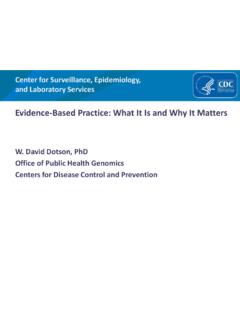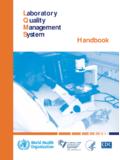Transcription of Cochrane Risk of Bias Tool - National Center for ...
1 D-1 Appendix D. Cochrane Risk of Bias Tool Cochrane collaboration modified tool for assessing risk of bias for RCT s, PART I Use this form to assess risk of bias for randomized controlled trials. Bias is assessed as a judgement (high, low, or unclear) for individual elements from five domains (selection, performance, attrition, reporting, and other). Risk of selection, reporting, and other bias are assessed in the Quality Assessment Form Part I. Risk of performance, detection, and attrition bias are assessed using the Quality Assessment Form Part II. Using the guidance provided at the end of this form, select either high , low or unclear for each judgment. When complete, proceed to Part II of the Quality Assessment Form REF ID: Domain Description High risk of bias Low risk of bias Unclear risk of bias Reviewer Assessment Selection bias Random sequence generation Described the method used to generate the allocation sequence in sufficient detail to allow an assessment of whether it should produce comparable groups.
2 Reviewer Comments: Selection bias (biased allocation to interventions) due to inadequate generation of a randomized sequence. Random sequence generation method should produce comparable groups Not described in sufficient detail Judgement Random sequence generation High Low Unclear Selection bias Allocation concealment Described the method used to conceal the allocation sequence in sufficient detail to determine whether intervention allocations could have been foreseen in advance of, or during, enrollment. Reviewer Comments: Selection bias (biased allocation to interventions) due to inadequate concealment of allocations prior to assignment. Intervention allocations likely could not have been foreseen in advance of, or during, enrollment Not described in sufficient detail Judgement Allocation concealment High Low Unclear Reporting bias Selective reporting Stated how the possibility of selective outcome reporting was examined by the authors and what was found.
3 Reviewer Comments: Reporting bias due to selective outcome reporting. Selective outcome reporting bias not detected Insufficient information to permit judgement (It is likely that the majority of studies will fall into this category.) Judgement Selective reporting High Low Unclear Other bias Other sources of bias Any important concerns about bias not addressed above. If particular questions/entries were pre-specified in the study s protocol, responses should be provided for each question/entry. Reviewer Comments: Bias due to problems not covered elsewhere in the table. No other bias detected There may be a risk of bias, but there is either i nsufficient information to assess whether an important risk of bias exists; or insufficient rationale or evidence that an identified problem will introduce bias.
4 Judgement Other sources of bias High Low Unclear D-2 Cochrane collaboration modified tool for assessing risk of bias for RCT s, PART II Use this form to assess risk of bias for randomized controlled trials. Bias is assessed as a judgement (high, low, or unclear) for individual elements from five domains of bias (selection, performance, attrition, reporting, and other). Risk of selection, reporting, and other bias are assessed in the Quality Assessment Form Part I. Risk of performance, detection, and attrition bias are assessed using the Quality Assessment Form Part II. Using the guidance provided at the end of this form, select either high , low or unclear for each judgement.
5 Risk of bias for the domains in the Form Part II will be assessed for each main or class of outcomes. Please indicate the specific outcome and complete the assessment for each. REF ID: Outcomes: Domain Description High risk of bias Low risk of bias Unclear risk of bias Reviewer Assessment Performance bias Blinding (participants and personnel) Described all measures used, if any, to blind study participants and personnel from knowledge of which intervention a participant received. Provided any information relating to whether the intended blinding was effective. Reviewer Comments: Performance bias due to knowledge of the allocated interventions by participants and personnel during the study.
6 Blinding was likely effective. Not described in sufficient detail Judgement Blinding (participants and personnel) High Low Unclear Detection bias Blinding (outcome assessment) Described all measures used, if any, to blind outcome assessors from knowledge of which intervention a participant received. Provided any information relating to whether the intended blinding was effective. Reviewer Comments: Detection bias due to knowledge of the allocated interventions by outcome assessors. Blinding was likely effective. Not described in sufficient detail Judgement Blinding (outcome assessment) High Low Unclear Attrition bias Incomplete outcome data Described the completeness of outcome data for each main outcome, including attrition and exclusions from the analysis.
7 Stated whether attrition and exclusions were reported, the numbers in each intervention group (compared with total randomized participants), reasons for attrition/exclusions where reported. Reviewer Comments: Attrition bias due to amount, nature or handling of incomplete outcome data. Handling of incomplete outcome data was complete and unlikely to have produced bias Insufficient reporting of attrition/exclusions to permit judgment of Low risk or High risk ( number randomized not stated, no reasons for missing data provided) Judgement Incomplete outcome data High Low Unclear















